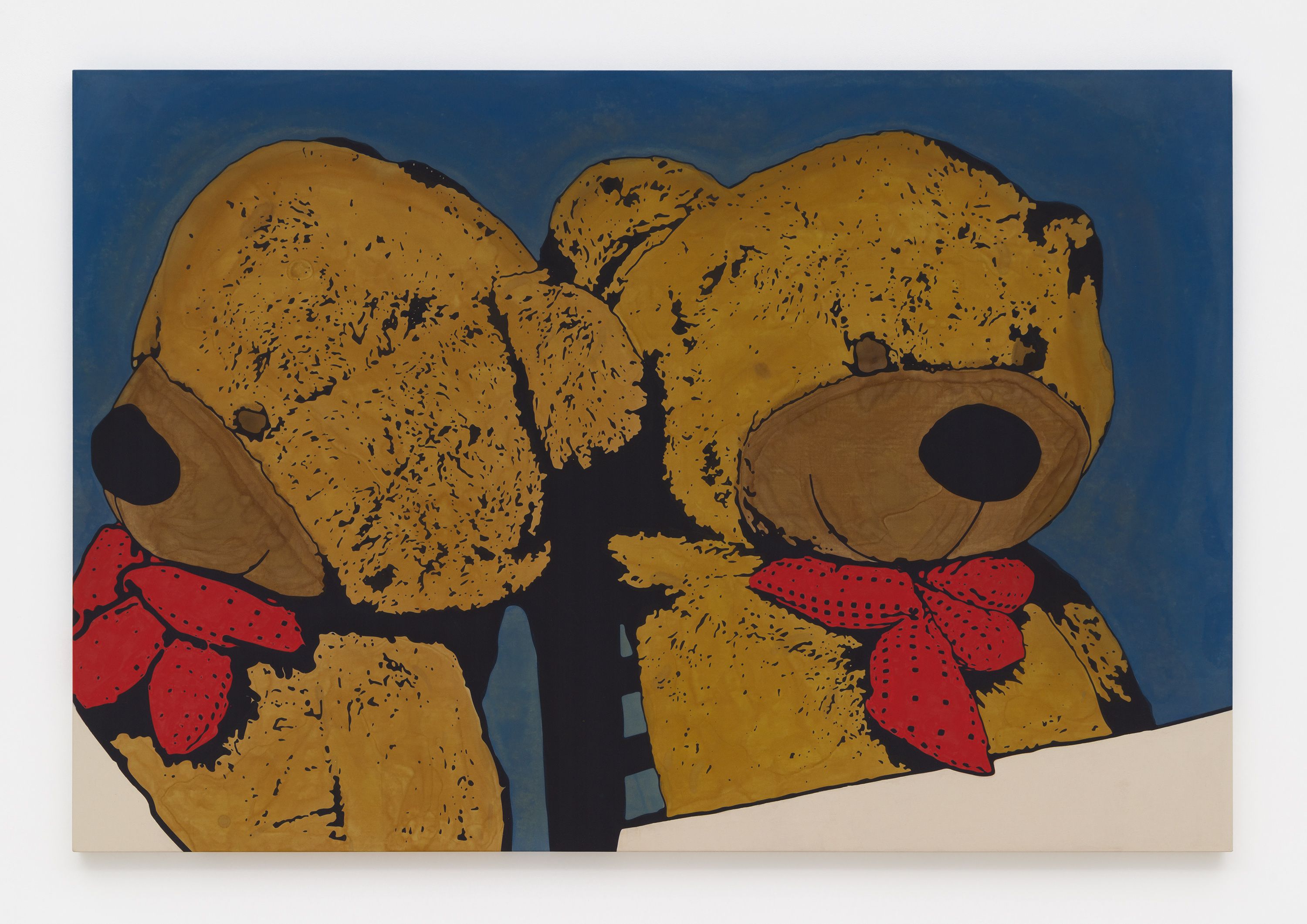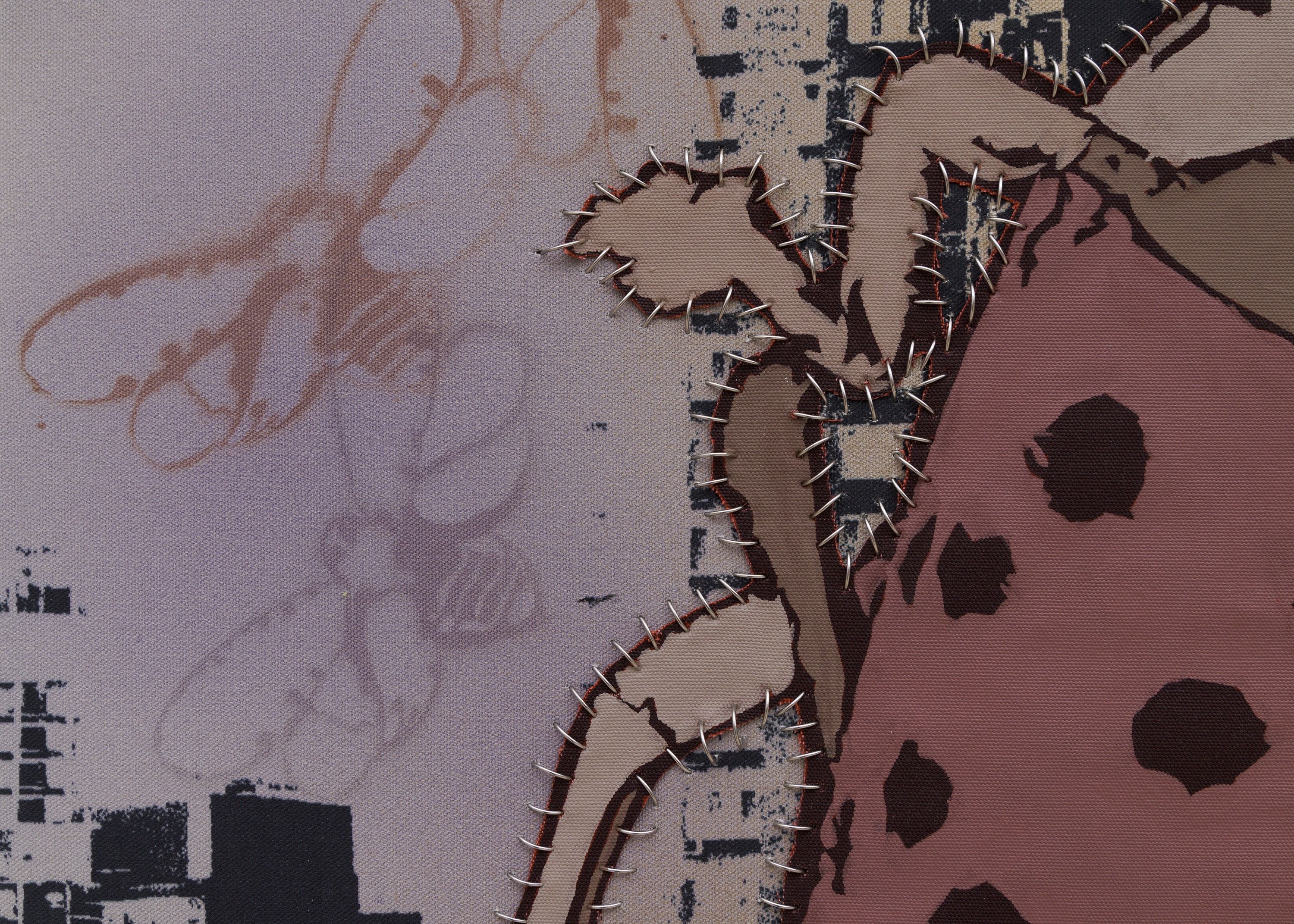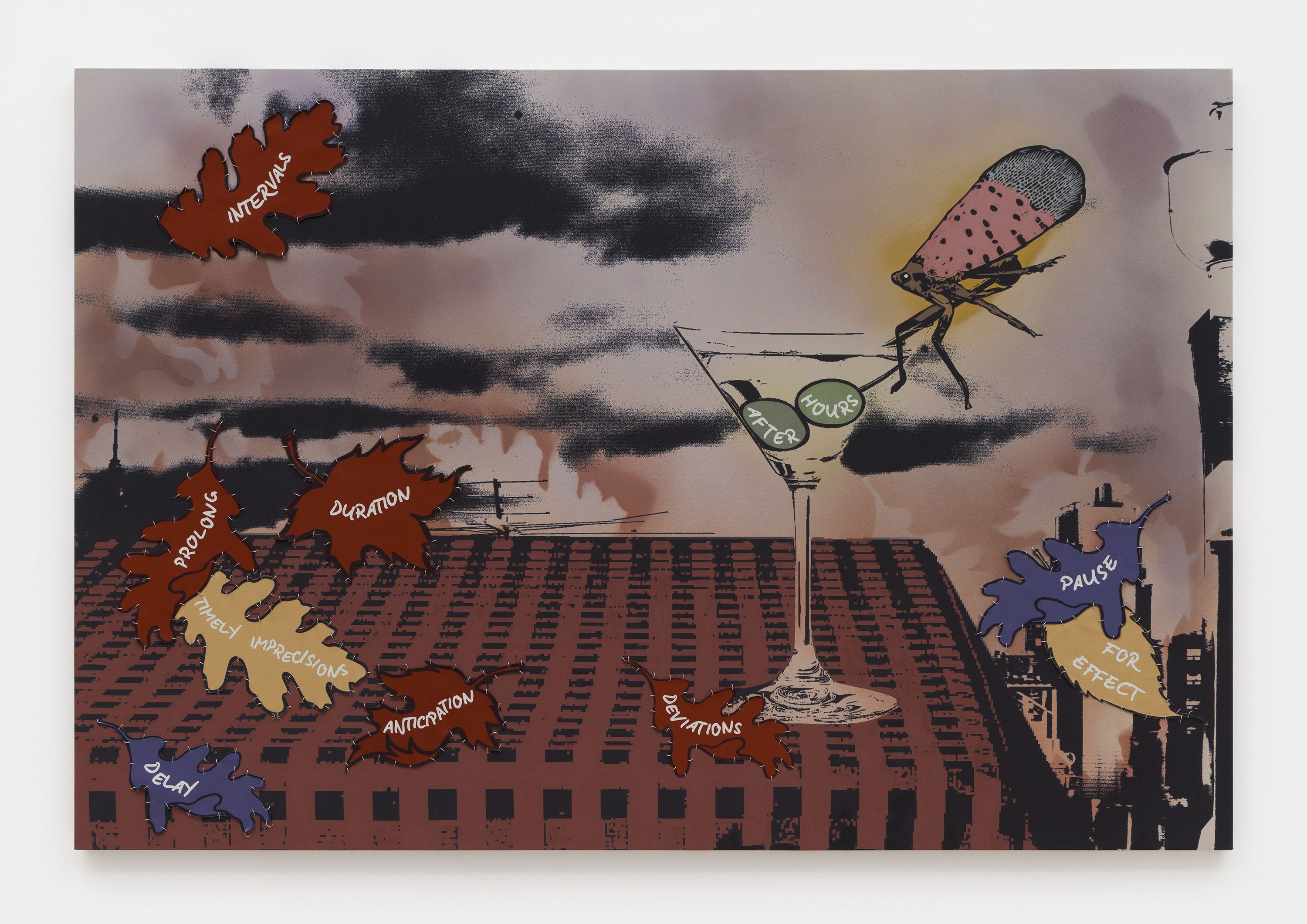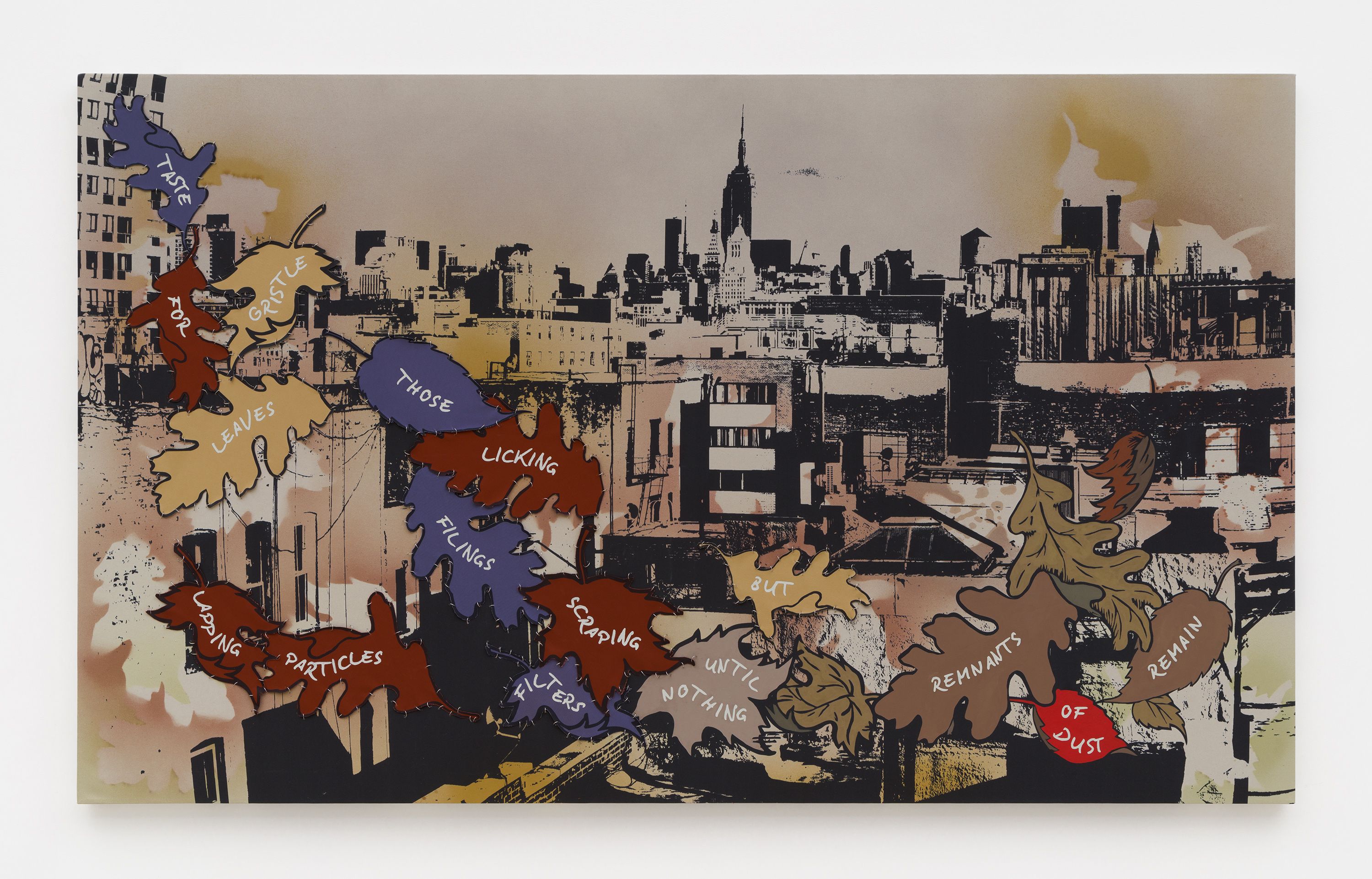
In a rapacious economy of micro-trends and perpetual vibe shifts, an artwork may seem like the ultimate slow medium. But as a cultural artifact inescapably marked by its zeitgeist, it is as temporal in nature as any viral blip encountered in the maelstrom of the content industrial complex.[1] For more than a decade, Dena Yago has studied this parallel in her simultaneous practices as artist and trend forecaster. Capacity, Yago’s first solo exhibition at JTT, reflects on the implicitly shared logics of these image-centered practices, both rooted in a logic of extreme presence, one contingent on perception and prediction.
Capacity comprises a series of inkjet printed and painted canvases depicting lonesome, haunted urban landscapes and scenes. Two characters that recur in Yago’s recent work make an appearance: the stuffed, oversized teddy bear (who, during the COVID pandemic were used as stand-ins for social distancing at cafes) and the spotted lanternfly (Lycorma delicatula, a beautiful but invasive species from Asia which first descended upon New York City in swarms in June 2020 in the midst of COVID and Black Lives Matter protests, prompting a public “if you see them, swat them” campaign). While the bears are seated together at quintessential checkered tableclothed tables enjoying Martini’s, the lanternfly is seen buzzing around the city, busy networking in various urban locales. These image-figures are like memes, perpetually re-appearing in their media network, where they begin to function as mediated quasi-subjects, somehow emblematic of their time.
The stylized DIY language of the canvases, synthesizing text and image on color planes in dyed bleeds of burnt orange and livid blue, resemble Situationist comics of the late 1960s, but also the album cover of This Nation’s Saving Grace (1985) by UK punk band The Fall. Twenty years apart, both drew allegorically on hyper-familiar cultural motifs in acid-tongued critiques of consumer capitalism. Every style returns, first as tragedy and then as farce, even in art—or at least it seems so if you line it up in teleological understandings of history. But Yago replaces a postmodern temporal logic of acceleration and “returns” with something closer to Walter Benjamin’s “angel of history.” This version of time sees change vibrationally, resembling the wings of a humming bird: when something moves fast enough, it eventually appears to stand still. Indeed, Benjamin’s angel (famously inspired by a Paul Klee painting) materializes in the exhibition’s central painting of the same name, where a lanternfly rests on a piling mass of last-mile delivery boxes. Yago’s paintings hint at the fact that there is nothing more static than the rapacious capitalist contemporary, an era of the perpetual now that has already lasted for almost three decades.
In this society, the artist—much like the trend forecaster—is herself an artifact of certain material processes and social effects, effectively tasked with predicting the future by producing it. This is a precarious position, an economy of capitalizing on media flows in order to survive. Yago’s canvases depict these slippery temporal dynamics allegorically, and not without a sense of tragic comedy. Capacity, here, gestures not only to the worker of the image, but that of the artwork itself.
Text by Jeppe Ugelvig
_____________________________________________
[1] Dena Yago, “Content Industrial Complex” in e-flux, Issue #89, March 2018.

acrylic and inkjet on canvas
54 x 80 in
137 x 203 cm

acrylic and inkjet on canvas
54 x 80 in
137 x 203 cm

acrylic and inkjet on canvas
54 x 74 in
137 x 188 cm

acrylic and inkjet on canvas
54 x 74 in
137 x 188 cm


acrylic and inkjet on canvas
54 x 80 in
137 x 203 cm

acrylic and inkjet on canvas
54 x 80 in
137 x 203 cm



acrylic and inkjet on canvas
54 x 54 in
137 x 137 cm

acrylic and inkjet on canvas
54 x 54 in
137 x 137 cm


acrylic and inkjet on canvas, stainless steel rings
54 x 90 in
137 x 228.5 cm

acrylic and inkjet on canvas, stainless steel rings
54 x 90 in
137 x 228.5 cm

acrylic and inkjet on canvas
54 x 90 in
137 x 228.5 cm

acrylic and inkjet on canvas
54 x 90 in
137 x 228.5 cm

acrylic and inkjet on canvas, stainless steel rings
54 x 90 in
137 x 228.5 cm

acrylic and inkjet on canvas, stainless steel rings
54 x 90 in
137 x 228.5 cm



acrylic and inkjet on canvas
54 x 100 in
137 x 254 cm

acrylic and inkjet on canvas
54 x 100 in
137 x 254 cm

acrylic and inkjet on canvas
54 x 100 in
137 x 254 cm

acrylic and inkjet on canvas
54 x 54 in
137 x 137 cm

acrylic and inkjet on canvas
54 x 54 in
137 x 137 cm



acrylic and inkjet on canvas, stainless steel rings
54 x 80 in
137 x 203 cm

acrylic and inkjet on canvas, stainless steel rings
54 x 80 in
137 x 203 cm

acrylic and inkjet on canvas
54 x 100 in
137 x 254 cm

acrylic and inkjet on canvas
54 x 100 in
137 x 254 cm

acrylic and inkjet on canvas, stainless steel rings
54 x 90 in
137 x 228.5 cm

acrylic and inkjet on canvas, stainless steel rings
54 x 90 in
137 x 228.5 cm

acrylic and inkjet on canvas, stainless steel rings
54 x 90 in
137 x 228.5 cm